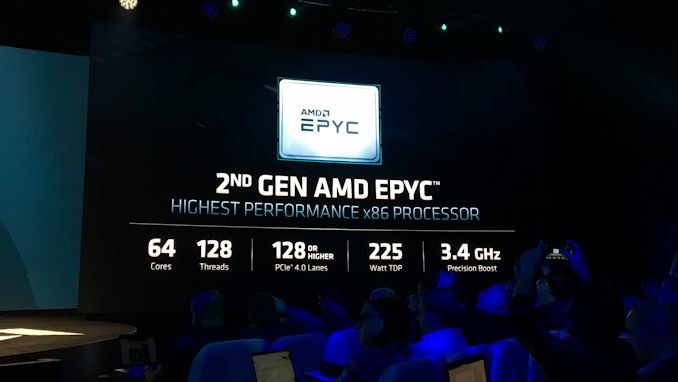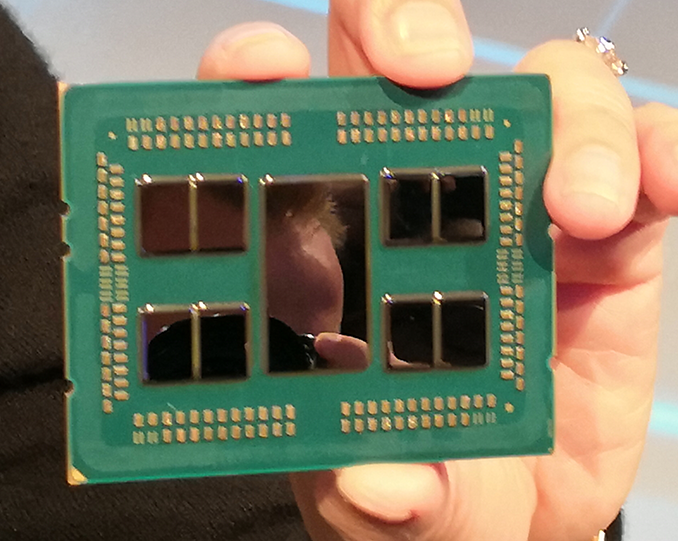AMD Rome Second Generation EPYC Review: 2x 64-core Benchmarked
by Johan De Gelas on August 7, 2019 7:00 PM ESTFirst Impressions
Due to bad luck and timing issues we have not been able to test the latest Intel and AMD servers CPU in our most demanding workloads. However, the metrics we were able to perform shows that AMD is offering a product that pushes out Intel for performance and steals the show for performance-per-dollar.
For those with little time: at the high end with socketed x86 CPUs, AMD offers you up to 50 to 100% higher performance while offering a 40% lower price. Unless you go for the low end server CPUs, there is no contest: AMD offers much better performance for a much lower price than Intel, with more memory channels and over 2x the number of PCIe lanes. These are also PCIe 4.0 lanes. What if you want more than 2 TB of RAM in your dual socket server? The discount in favor of AMD just became 50%.
We can only applaud this with enthusiasm as it empowers all the professionals who do not enjoy the same negotiating power as the Amazons, Azure and other large scale players of this world. Spend about $4k and you get 64 second generation EPYC cores. The 1P offerings offer even better deals to those with a tight budget.
So has AMD done the unthinkable? Beaten Intel by such a large margin that there is no contest? For now, based on our preliminary testing, that is the case. The launch of AMD's second generation EPYC processors is nothing short of historic, beating the competition by a large margin in almost every metric: performance, performance per watt and performance per dollar.
Analysts in the industry have stated that AMD expects to double their share in the server market by Q2 2020, and there is every reason to believe that AMD will succeed. The AMD EPYC is an extremely attractive server platform with an unbeatable performance per dollar ratio.
Intel's most likely immediate defense will be lowering their prices for a select number of important customers, which won't be made public. The company is also likely to showcase its 56-core Xeon Platinum 9200 series processors, which aren't socketed and only available from a limited number of vendors, and are listed without pricing so there's no firm determination on the value of those processors. Ultimately, if Intel wanted a core-for-core comparison here, we would have expected them to reach out and offer a Xeon 9200 system to test. That didn't happen. But keep an eye out on Intel's messaging in the next few months.
As you know, Ice lake is Intel's most promising response, and that chip will be available somewhere in the mid of 2020. Ice lake promises 18% higher IPC, eight instead of six memory channels and should be able to offer 56 or more cores in reasonable power envelope as it will use Intel's most advanced 10 nm process. The big question will be around the implementation of the design, if it uses chiplets, how the memory works, and the frequencies they can reach.
Overall, AMD has done a stellar job. The city may be built on seven hills, but Rome's 8x8-core chiplet design is a truly cultural phenomenon of the semiconductor industry.
We'll be revisiting more big data benchmarks through August and September, and hopefully have individual chip benchmark reviews coming soon. Stay tuned for those as and when we're able to acquire the other hardware.
Can't wait? Then read our interview with AMD's SVP and GM of the Datacenter and Embedded Solutions Group, Forrest Norrod, where we talk about Napes, Rome, Milan, and Genoa. It's all coming up EPYC.
An Interview with AMD’s Forrest Norrod: Naples, Rome, Milan, & Genoa













180 Comments
View All Comments
negusp - Wednesday, August 7, 2019 - link
hard F in the chat for intelpancakes - Wednesday, August 7, 2019 - link
F in chat for wallets of people running Windows serverazfacea - Wednesday, August 7, 2019 - link
windows server in 2019 LULdiehardmacfan - Wednesday, August 7, 2019 - link
on-prem Windows Server is probably at an all time high in 2019?azfacea - Thursday, August 8, 2019 - link
desperate for a comeback huh? cool hold your 10% tight and gloat about upcoming bfloat16diehardmacfan - Thursday, August 8, 2019 - link
Sorry, who is desperate for a comeback? Bring up a floating point format when called out on the ridiculous notion that Windows Server isn't still a large part of the marketplace? say whamkaibear - Thursday, August 8, 2019 - link
Just hopping in to say that I am an IT manager for a major employer in the UK and of our 1800 servers more than 80% of them are Windows... this is not a trend which I see changing any time soon.Deshi! - Thursday, August 8, 2019 - link
I work as an application engineer for a major global finance company that develops and hosts banking and e-commerce software used by banks and major shopping outlets. 90% of all our servers are either Linux or AIX mainly running websphere or standalone Java instances. We only have a handful of Windows servers, mainly for stuff like active directory and Outlook/ SharePoint. So yeah allot of it depends on the use case, but allot of the big boys do use Linux or AIX. It's cheaper and performs better for these use cases.cyberguyz - Thursday, August 8, 2019 - link
I guess we all have to ask ourselves, who are the customers that would benefit most from a 64-core, 128 gen 4 PCIe processors? SMB or huge customers that would shell out many millions of $$$ for their middleware & backend systems? @Deshi! I or one of my L3 colleagues an L3 engineer contacted by your global finance company to fix Websphere problems some years back ;)FreckledTrout - Thursday, August 8, 2019 - link
@cyberguz, Who would benefit from these high core servers? Any company running VM's so pretty much every large company. This goes doubly for cloud providers.